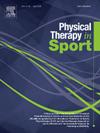TeamGym在正常和减少训练期间的运动相关疼痛患病率:对579名丹麦体操运动员的调查
IF 2.2
3区 医学
Q1 REHABILITATION
引用次数: 0
摘要
目的了解TeamGym体操运动员的疼痛发生率及其区域分布;其次,比较正常训练负荷和减少训练负荷期间的疼痛发生率。DesignCross-sectional研究。本研究纳入了(1)正常训练负荷时期(2020年8月至12月)和(2)训练负荷减少时期(2021年1月至6月,COVID-19限制)的数据。参与者为10-30岁的蒸汽体操运动员。主要结果测量:自述疼痛/不适史。结果579名入选体操运动员在两个时间点的调查完成率均为65%。由于体操引起的疼痛发生率为80%,最常见的疼痛区域是膝盖(20% [95% CI 18.1;21.8]),手腕(17% [95% CI 15.5;19.0])和足(16% [95% CI 14.4;17.8])。所有病例中有42%描述为逐渐疼痛发作。在减少训练时间期间,疼痛区域的数量减少了26%,但区域身体疼痛分布保持不变。结论:5个体操运动员中有4个在正常的5个月训练期间经历过疼痛/不适。膝关节、腕部和足部是最常见的疼痛区域,并以逐渐疼痛为主。减少训练负荷降低了绝对疼痛发生率,但区域身体分布不受影响。本文章由计算机程序翻译,如有差异,请以英文原文为准。
Sports-related pain prevalence in TeamGym during normal and reduced training periods: A survey of 579 Danish gymnasts
Objectives
To describe the pain prevalence and its regional body distribution in TeamGym gymnasts, and secondly, to compare pain prevalence during a period with normal training load with a period with reduced training load.
Design
Cross-sectional study.
Setting
Data from (1) a period with normal training load (Aug–Dec 2020), and (2) a period with reduced training load (COVID-19 restrictions, Jan–June 2021) were included.
Participants
TeamGym gymnasts aged 10–30 years.
Main outcome measures
Self-reported history of pain/discomfort.
Results
In total, 65 % of the invited gymnasts completed the survey at both time points, which included 579 gymnasts. The pain prevalence due to gymnastics was 80 % with the most prevalent pain regions being knee (20 % [95 %CI 18.1; 21.8]), wrist (17 % [95 %CI 15.5; 19.0]) and foot (16 % [95 %CI 14.4; 17.8]). Gradual pain onset was described in 42 % of all cases. During the reduced training period, the number of painful regions decreased by 26 %, but regional body pain distribution remained unchanged.
Conclusions
Four of five gymnasts experienced pain/discomfort during a normal five-month training period. Knee, wrist and foot were the most common painful regions with gradual pain onset as the most frequently reported. Reduced training load decreased the absolute pain prevalence, but regional body distribution was unaffected.
求助全文
通过发布文献求助,成功后即可免费获取论文全文。
去求助
来源期刊

Physical Therapy in Sport
医学-康复医学
CiteScore
4.50
自引率
8.30%
发文量
125
审稿时长
39 days
期刊介绍:
Physical Therapy in Sport is an international peer-reviewed journal that provides a forum for the publication of research and clinical practice material relevant to the healthcare professions involved in sports and exercise medicine, and rehabilitation. The journal publishes material that is indispensable for day-to-day practice and continuing professional development. Physical Therapy in Sport covers topics dealing with the diagnosis, treatment, and prevention of injuries, as well as more general areas of sports and exercise medicine and related sports science.
The journal publishes original research, case studies, reviews, masterclasses, papers on clinical approaches, and book reviews, as well as occasional reports from conferences. Papers are double-blind peer-reviewed by our international advisory board and other international experts, and submissions from a broad range of disciplines are actively encouraged.
 求助内容:
求助内容: 应助结果提醒方式:
应助结果提醒方式:


